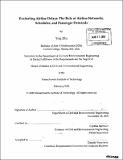| dc.contributor.advisor | Cynthia Barnhart. | en_US |
| dc.contributor.author | Zhu, Ying, S.M. Massachusetts Institute of Technology | en_US |
| dc.contributor.other | Massachusetts Institute of Technology. Dept. of Civil and Environmental Engineering. | en_US |
| dc.date.accessioned | 2009-10-01T15:41:19Z | |
| dc.date.available | 2009-10-01T15:41:19Z | |
| dc.date.copyright | 2008 | en_US |
| dc.date.issued | 2009 | en_US |
| dc.identifier.uri | http://hdl.handle.net/1721.1/47775 | |
| dc.description | Thesis (S.M.)--Massachusetts Institute of Technology, Dept. of Civil and Environmental Engineering, 2009. | en_US |
| dc.description | Includes bibliographical references (p. 141-143). | en_US |
| dc.description.abstract | In this thesis, we develop a framework for analyzing airlines' operational performances under different strategic decisions. A detailed study is conducted to compare differences between a major U.S. legacy carrier and a major U.S. low-cost carrier in terms of their scheduling practices, flight-based delays and on-time performances, network operations and mix of passengers, as well as passenger delays and disruptions. One major contribution of this thesis is that the framework we develop to evaluate airlines' performances is not restricted by the availability of proprietary airline data and can be adopted to estimate itinerary-based passenger demand for any U.S. airline included in the Bureau of Transportation Statistics database. Moreover, in this thesis, we compute delay for local and connecting passengers and provide a powerful tool for scenario analysis. Further, we: (1) identify root causes of delays as well as the impact throughout the network; (2) gain insights about how passenger delay can be reduced with different scheduling practices; and (3) guide the design of on-time performance metrics. Differences in scheduling practices, network operations, passenger mix, aircraft delays, and passenger delays between different airlines arise from carrier-specific characteristics. These characteristics should be considered when designing on-time performance metrics. | en_US |
| dc.description.abstract | (cont.) Characteristics specific to the legacy carrier are: (1) its hubs experience heavy traffic volume and are often subject to ground delay programs (GDPs) caused by poor weather conditions; and (2) it operates banked hubs where a set of arriving flight legs are scheduled closely with a set of departing flight legs to allow passenger connections between arriving and departing flight legs. Characteristics specific to the low-cost carrier are: (1) it tends to fly into locations that are less impacted by weather conditions and less frequently subjected to GDPs; (2) passenger traffic is distributed more evenly in the system, unlike the case of the legacy carrier in which a much larger portion of passengers connect through the major hubs; and (3) it has depeaked schedules at the major airports which allow the carrier to achieve higher efficiency in turning aircraft. Another important distinction between the two airlines that needs to be considered when designing on-time performance metrics is: the ratio of passenger delay (especially disrupted passenger delay) to operated flight delay for the low-cost carrier was higher than the corresponding value for the legacy carrier. This difference indicates that flight-specific on-time performance metrics that ignore airline heterogeneity can be an inaccurate measure of passenger experiences. In this thesis, scenario representations pertaining to various levels of airport traffic under different weather conditions are analyzed within our framework. We measure passenger delays (that is, the positive difference between the actual arrival time of the passenger at his/her destination and the scheduled arrival time) and passenger disruptions, with a passenger disruption defined as a passenger who is re-booked on an itinerary other than that planned due to a missed connection or flight cancellation. | en_US |
| dc.description.abstract | (cont.) Our results show that for the legacy carrier, an increase in flight operations of one percent on the "high-delay" day translates to an increase in the percentage of disrupted passengers (average disrupted passenger delay) of 22.2% (3.1%); for the low-cost carrier, an increase in flight operations of one percent only increases the percentage of disrupted passengers (average disrupted passenger delay) by 12.3% (2.7%). The above statistics suggest that under poor weather conditions, increasing flight operations at busy airports, compared to non-congested airports, can cause a much greater increase in passenger delay and disruptions when airport capacity is reduced by adverse weather condition. | en_US |
| dc.description.statementofresponsibility | by Ying Zhu. | en_US |
| dc.format.extent | 143 p. | en_US |
| dc.language.iso | eng | en_US |
| dc.publisher | Massachusetts Institute of Technology | en_US |
| dc.rights | M.I.T. theses are protected by
copyright. They may be viewed from this source for any purpose, but
reproduction or distribution in any format is prohibited without written
permission. See provided URL for inquiries about permission. | en_US |
| dc.rights.uri | http://dspace.mit.edu/handle/1721.1/7582 | en_US |
| dc.subject | Civil and Environmental Engineering. | en_US |
| dc.title | Evaluating airline delays : the role of airline networks, schedules, and passenger demands | en_US |
| dc.type | Thesis | en_US |
| dc.description.degree | S.M. | en_US |
| dc.contributor.department | Massachusetts Institute of Technology. Department of Civil and Environmental Engineering | |
| dc.identifier.oclc | 428977342 | en_US |
